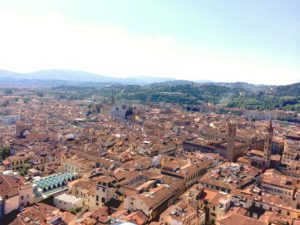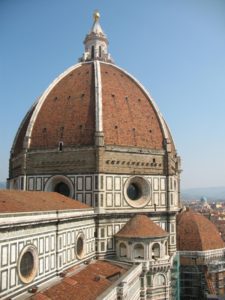
How To Find Five High-Class Views Of Florence On A Steerage Budget
by Nicole Clausing
In the 1985 film A Room with a View (Two-Disc Special Edition), we are memorably introduced to two of the main characters—both born to England’s Edwardian-era upper class—as they are in the middle of an epic sulk. The pair, played by Helena Bonham Carter and Maggie Smith, are aggrieved at discovering that the rooms they have been assigned at their pensione do not have the view they felt they were promised.
At first, their peevishness seems a little silly. For one thing, the view they are missing out on is of the Arno River—lovely, to be sure, but about as hard to spot in Florence as the Eiffel Tower is in Paris. They’re going to see it all day—surely they can live without waking up to it as well?
Another thing that makes their little snit even more ridiculous is the revelation that the windows they do have look out over a small Oltrarno neighborhood square. Maggie Smith turns up her nose at the sight of ordinary Italians scurrying to and fro, going about their everyday lives. But seasoned travelers know that the chance to get a glimpse of the real life of a place is just about priceless.
Still, it’s hard not to sympathize at all. Florence is a beautiful city and finding yourself with nothing pretty to look is something you just shouldn’t have to put up with no matter what kind of budget you’re on.
Here, then is a brief guide to finding Florence’s most striking vistas. Remarkably, some are free—and you don’t have to spend a duchess’ inheritance to access any of them. (Well, maybe one, but it’s definitely optional.)
The Duomo
Florence’s central cathedral, usually known as the Duomo but officially called the Basilica di Santa Maria (Piazza Duomo, +39 055 2302885, en.grandemuseodelduomo.waf.it/museo_dett.php?idtour=8484), might almost seem too obvious, too touristy, to be worth consideration for the 10 Euro admission, which includes Campanile as well. But it’s popular for a reason. It’s been the heart of Florence at least since the cornerstone was laid in 1296. (And probably longer—a church has existed on this spot since the 4th century.) When the magnificent dome was finally completed in 1436, it was the largest in Christendom. Not even the Vatican can compete—St. Peter’s Basilica is a little taller, but its dome isn’t quite as large in circumference.

It’s spectacular enough to walk among the pews in the cathedral, taking in the light streaming through Lorenzo Ghiberti’s stained glass windows and straining to see the details of frescoes inside Brunelleschi’s dome, high above your head. But it’s worth a few Euros and a large portion of quad strength to ascend to the top of the dome, 376 feet above the square below. (There are no elevators—the only way up is to hoof it up 463 steps.)
Your first views are of the inside of the church. As you ascend the seemingly endless flights of stairs, you can see that the marble floor of has a labyrinth pattern laid out on it. As you climb higher, and penitents and tourists all become increasingly more antlike, you get a close-up view of those interior Vasari frescoes. They tell the story of the Last Judgment, and portray, in vivid detail, the almost comically absurd horrors that await sinners in the afterlife.
When you get to the level of the widest part of the dome, you may feel you’ve entered a sort of purgatory yourself. At this point, you move into a netherworld between dome support shells, and dark, narrow stairs made for tiny medieval people twist and turn upward seemingly forever. Stick with it—and watch for signs telling you where to go. Some of the staircases are so narrow that they are one-way, and it’s important that you not try to salmon up a down staircase. Try it, and you will be greeted by tired pilgrims who, fresh from viewing Vasari’s images of Hell, will be happy to tell you how to get there.
Just when you think you can’t climb another step, the gods answer your prayers—by throwing some ladders in your path. Scale them, and your reward is fresh air and the view from the top of Florence. The whole city is at your feet, and from this height, it looks like the town is paved with red tile. The most obvious landmark is Giotto’s Campanile, immediately adjacent to the church, and clad in the same pink and green marble. The Uffizi and the churches of Santa Croce and Santa Maria Novella are easy to spot. Look directly down, and you can see the Baptistry, one of the oldest buildings in Florence. Look to the edge of the terra-cotta sprawl, and you can see cranes building Florence’s newest edifices, mostly office buildings and convention centers. On a good day, you can look beyond even that, to the timeless vista of the Tuscan hills.

Campanile
If you’ve braved the Duomo, this climb is optional, but worth it if you have the time and the stamina. (No elevator here, either.) The Campanile (Piazza Duomo, +39 055 2302885, en.grandemuseodelduomo.waf.it/museo_dett.php?idtour=8484) also costs 10 Euro admission and includes Duomo which is right next to it and about 20 feet shorter—so the views of the city are similar and just the tiniest bit less spectacular than from the roof of the church.
What you do get from the top of the tower, besides blisters, is a close-up view of the Duomo itself. This high up, and this close to the cathedral, you can see details that earthbound Florentines can’t. You’ll notice colorful tilework, masonry frills, and other pieces of workmanship that anonymous and devoted medieval craftsmen must have thought would only be seen by God.
Piazzale Michelangelo
You don’t always have to scale a building to get a view in Florence. La Cittá Bella is surrounded by hills, and you don’t have to climb too high to find a nice vista.
One spot that is reachable by either a half-hour walk or a short bus ride (bus #13) from the city center is the Piazzale Michelangelo. This plaza, at the south edge of town, is full of souvenir vendors and dotted with weather-beaten reproductions of works by Michelangelo—a large and greenish David dominates the center of the square.
By far the greatest attraction of the Piazzale is the view to the north of most of Florence. Removed from the center of town, you get a good idea of the geography of the place. You can see the Duomo in the center of things, looming over the plane of red roofs the way Devil’s Tower shoots out of the flats of Wyoming. The Uffizi stands tall nearby, and it’s clear that the whole of Florence revolves around that central area. Santa Croce and Santa Maria Novella churches face off against each other from opposite ends of the central city, and the Arno slashes through the whole scene.
The river doesn’t divide the city into fashionable and less-fashionable banks anymore, but you can clearly see that it did for about 1,000 years. North of the river, all the major tourist attractions and grand facades are clustered; south of the river, it’s all parks, low-rise buildings and warrens of alleyways lined with traditional workshops.

San Mineato al Monte
If you have more hike in you, consider walking about another 10 minutes uphill from the Piazzale Michelangelo. This will bring you to the church of San Mineato al Monte (Via delle Porte Sante 34, +39 055 234 2731, san-miniato-al-monte.com). The admission is free and your reward is an even better, less obstructed view of the city, smaller crowds, and a sight—the old church itself—that would be worth the trip even without the view.
The church isn’t a soaring gothic structure like most you’ll find in your guidebook. San Mineato al Monte is old even by European standards, built in 1018 in a sturdy, Romanesque style. The façade is made of beautiful local marble, and the largely wooden interior is covered in charmingly stiff painted figures—the style is pre-renaissance, and contrasts interestingly with the gloriously detailed and masterfully lifelike art the city would become famous for a few hundred years later.
And the view! If you have ever seen a tourism bureau photo of the city, chances are it was taken from exactly this vantage point in front of the church. You’re not more than a few hundred feet higher than you were at Piazzale Michelangelo, but as renaissance artists knew well, perspective is everything. Somehow the view from in front of San Mineato al Monte is just exactly right—close enough to pick out landmarks easily, but distant enough to give you a feel for how the landmarks fit into the greater city and indeed the whole region. Getting to the church and back can eat the majority of a precious afternoon in Florence, but on a clear day you will not regret the indulgence.
Camere con Vista
Finally, if you really must have that view that those movie characters were so petulant about, it can be yours—for a price. The hotel where the pensione scenes were filmed is still in business. It’s called the Hotel degli Orafi (Lungarno degli Archibusieri 4, +39 055 26622, hoteldegliorafi.it/english/camere_con_vista.php). Ask for the camere con vista—the room with the view—and you’ll get the exact chamber with the Duomo-framing window featured on the movie poster. (Spoiler: Helena Bonham Carter’s character gets her view. It’s not the only thing that happens in the movie.)
All this will cost you. The view room must be reserved for two nights, which will cost nearly US $1,000 in the off-season. It goes up from there. (To be fair, breakfast is included.)
Still, if you’re ever going to splurge on a pretty thing, Florence would be the place to do it. The city has been all about beauty since the time of Michelangelo, and its people have been expending effort to access the city’s views since at least that dark-ages day when construction started on the San Mineato al Monte church.
So you can make like the posh ladies in the movie, and spare no expense in the pursuit of beauty. It’s an ancient Florentine tradition, after all. Or, do what I would: Stay on the cheap, hike up the stairs and hills, and reward yourself by spending your hotel savings on gelato and prosecco at a riverside café.
Either way, it all goes to show that in Florence, the most beautiful things are, one way or another, available to everyone.
Book your next trip to Florence, Italy with Girls That Roam Travel. Contact Heather Cassell at Girls That Roam Travel in association with Travel Advisors of Los Gatos at 415-517-7239 or at .
To contract an original article, purchase reprints or become a media partner, contact .







